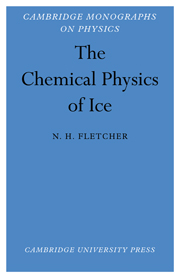Book contents
- Frontmatter
- Contents
- Preface
- Note on Units
- CHAPTER 1 The water molecule
- CHAPTER 2 Structure and energy of ordinary ice
- CHAPTER 3 Other forms of ice
- CHAPTER 4 Liquid water and freezing
- CHAPTER 5 Crystal growth
- CHAPTER 6 Thermal properties and lattice dynamics
- CHAPTER 7 Point defects
- CHAPTER 8 Mechanical properties
- CHAPTER 9 Electrical properties
- References
- Subject Index
CHAPTER 6 - Thermal properties and lattice dynamics
Published online by Cambridge University Press: 21 May 2010
- Frontmatter
- Contents
- Preface
- Note on Units
- CHAPTER 1 The water molecule
- CHAPTER 2 Structure and energy of ordinary ice
- CHAPTER 3 Other forms of ice
- CHAPTER 4 Liquid water and freezing
- CHAPTER 5 Crystal growth
- CHAPTER 6 Thermal properties and lattice dynamics
- CHAPTER 7 Point defects
- CHAPTER 8 Mechanical properties
- CHAPTER 9 Electrical properties
- References
- Subject Index
Summary
In this chapter we shall discuss those properties of ice crystals which derive essentially from the thermal motions of water molecules within the crystal structure. In broad outline the theory describing these phenomena is simple and well known and leads to simple generalizations like the Debye theory of specific heats. However, because of the structure of the water molecule and, deriving from it, the structure of the ice crystal, such theories in their simple form represent only a first approximation to the observed behaviour. The coefficient of thermal expansion, for example, is negative at low temperatures and the specific heat is only poorly described by a Debye curve. It will be in tracing the reasons for some of these deviations from simple behaviour that most of our interest will lie.
Thermal expansion
The coefficient of thermal expansion can be determined in two different ways. The first, and most direct, is simply to take a single crystal of ice and measure its dimensions as a function of temperature. From the symmetry of the crystal the results can be expressed in terms of two linear expansion coefficients: α = l1(dl/dT) in directions parallel to the c–axis and to an a–axis respectively. Alternatively X–ray diffraction methods can be used to measure the c and a dimensions of the unit cell as a function of temperature.
- Type
- Chapter
- Information
- The Chemical Physics of Ice , pp. 130 - 146Publisher: Cambridge University PressPrint publication year: 1970



